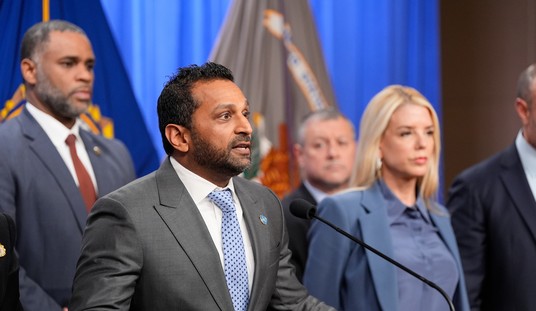Did the Supreme Court rebuke district court judges in a 'landmark' ruling yesterday? Or did they narrowly split the baby on procedural grounds?
John wrote last night about the 5-4 decision to vacate a TRO by Judge James Boasberg that had halted deportation proceedings under the Alien Enemies Act. Today, Attorney General Pam Bondi declared victory for "the rule of law" and executive prerogative:
“These liberal district judges thought they could control our entire country’s policy”: @AGPamBondi says deportation flights will continue after the Supreme Court’s ruling. pic.twitter.com/V7mIDB6Hqn
— FOX & Friends (@foxandfriends) April 8, 2025
One cannot blame Bondi for taking a victory lap here, but the case is not yet settled on the pending deportations. The 5-4 split, with Justice Amy Coney Barrett aligning with the three liberal justices, portends some more difficult arguments ahead for Bondi and her team at the Department of Justice. And note that no one will be deported based on this vacatur -- at least not immediately.
The per curiam order did have some good news for Bondi and the Trump administration. It does implicitly impose a jurisdictional limitation on district courts, although "implicit" may not be strong enough to force federal judges into modesty on TROs. The primary thrust of the Supreme Court decision is that Boasberg overstepped by taking the case at all. If the plaintiffs want to challenge their detention, the Supreme Court ruled, the proper venue is the district in which they are presently detained -- Texas -- rather than DC:
Regardless of whether the detainees formally request release from confinement, because their claims for relief “‘necessarily imply the invalidity’ ” of their confinement and removal under the AEA, their claims fall within the “core” of the writ of habeas corpus and thus must be brought in habeas. Cf. Nance v. Ward, 597 U. S. 159, 167 (2022) (quoting Heck v. Humphrey, 512 U. S. 477, 487 (1994)). And “immediate physical release [is not] the only remedy under the federal writ of habeas corpus.” Peyton v. Rowe, 391 U. S. 54, 67 (1968); see, e.g., Nance, 597 U. S., at 167 (explaining that a capital prisoner may seek “to overturn his death sentence” in habeas by “analog[y]” to seeking release); In re Bonner, 151 U. S. 242, 254, 259 (1894). For “core habeas petitions,” “jurisdiction lies in only one district: the district of confinement.” Rumsfeld v. Padilla, 542 U. S. 426, 443 (2004). The detainees are confined in Texas, so venue is improper in the District of Columbia.
Will that be enough to end "judge shopping" and nationwide TROs by district court judges? Color me skeptical in the extreme. The court will have to deliver more explicit language on that point, and may well have to promulgate new rules for federal courts in order to end that pernicious -- and now universally used -- strategy.
However, the court's order leaves open a challenge to the validity of the Alien Enemies Act as part of the habeas actions these detainees can bring in the proper venue. In fact, the order underscores that these detainees do have the right to at least that basic level of judicial review prior to removal, and that the government has to allow the detainees enough time to file such actions and have their cases heard:
Challenges to removal under the AEA, a statute which largely “‘preclude[s] judicial review,’” Ludecke v. Watkins, 335 U. S. 160, 163−164, (1948), must be brought in habeas. Cf. Heikkila v. Barber, 345 U. S. 229, 234−235 (1953) (holding that habeas was the only cause of action available to challenge deportation under immigration statutes that “preclud[ed] judicial intervention” beyond what was necessary to vindicate due process rights).
A habeas petition forces the government to provide proof of its case against the petitioners. In this case, it would likely require the Trump administration to demonstrate evidence in each individual case that the detainee belongs or has an affiliation with Tren de Aragua or other criminal/terror activity. The government conceded that during the appeals process:
The detainees also sought equitable relief against summary removal. Although judicial review under the AEA is limited, we have held that an individual subject to detention and removal under that statute is entitled to “‘judicial review’” as to “questions of interpretation and constitutionality” of the Act as well as whether he or she “is in fact an alien enemy fourteen years of age or older.” Ludecke, 335 U. S., at 163−164, 172, n. 17. (Under the Proclamation, the term “alien enemy” is defined to include “all Venezuelan citizens 14 years of age or older who are members of TdA, are within the United States, and are not actually naturalized or lawful permanent residents of the United States.” 90 Fed. Reg. 13034.) The detainees’ rights against summary removal, however, are not currently in dispute. The Government expressly agrees that “TdA members subject to removal under the Alien Enemies Act get judicial review.” Reply in Support of Application To Vacate 1.
In other words, there will be no more snap deportation flights, and least not under the AEA. Those with existing deportation orders are a different matter.
The other potential good news here is that the court seems to tacitly accept the application of the Alien Enemies Act by the Trump administration against criminal gangs of illegal aliens. The controlling order makes no mention of a dispute over the AEA. However, it does imply that the detainees can challenge that in their habeas actions too. The court punted on that question (emphasis mine):
We grant the application and vacate the TROs. The detainees seek equitable relief against the implementation of the Proclamation and against their removal under the AEA. They challenge the Government’s interpretation of the Act and assert that they do not fall within the category of removable alien enemies. But we do not reach those arguments.
Technically, then, the Supreme Court has not validated this exercise under the AEA. Nor did they intend to do so, but instead actively avoided it. Curiously, the dissents never really substantially address this either. Justice Sonia Sotomayor's complaint rests largely on the lack of a public proclamation as required by the AEA before the detentions and transfers began. It's entirely possible that the Texas court will rule that the AEA doesn't apply outside of a declaration of war and could invalidate the detentions -- perhaps an unlikely outcome, but this decision does not preclude it.
In other words, this decision is a step in the right direction. But it doesn't actually settle much other than proper venue and the right of detainees to habeas corpus, a rather basic and unremarkable point, as Justice Brett Kavanaugh notes in his brief concurrence. Keep the champagne on ice for a while longer.







Join the conversation as a VIP Member